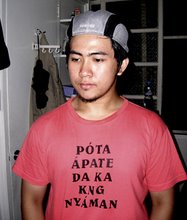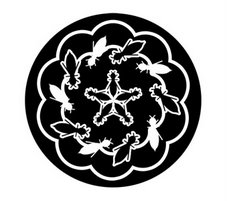[An article titled Counting in Kapampangan by Robby Tantingco]
Quick! Translate this into Kapampangan: one million six hundred fourteen thousand, nine hundred and forty-two (1,614,942).
Metung a milyun, anam a ralan labing apat a libu, siyam a ralan apat a pulu't adua. Correct?
Wrong!
It should be: Sangyuta lauit anam a gatus metung lacsa apat a libu, siyam a ralan mecalimang adua.
That's the total population of Pampanga today in the original Kapampangan numerical system, which was recorded by Augustinian missionary Fray Francisco Coronel in 1617, and which has since disappeared.
Ancient Kapampangans did not learn how to count from the Spaniards. By the time the invaders came in 1571, Pampanga had already been a fully functioning civilization, with community life, commerce, religion, calendar of festivals, agriculture that produced surplus (which enabled our ancestors to trade with other nations), a writing system and yes, a counting system, just like many other ethno-linguistic tribes in the archipelago.
When the Spaniards landed in
Subsequent generations of Kapampangans unlearned the traditional counting system and adopted the Western way. Too bad, because our Kapampangan counting system could count all the way to one million. This means our ancestors had built a society large enough and sophisticated enough to contain concepts and objects that necessitated a word for million.
Here are the Kapampangan words for numbers one to one million, as documented by Spanish missionary Fray Francisco Coronel in a Kapampangan grammar book written in 1617, barely 50 years after the Spaniards first sailed into Pampanga:
Isa, adua, atlu, apat, lima, anam, pitu, walu, siam, pulu.
Isa (one) is used in counting, while metung is used as an adjective to describe something (as in metung a bulig, not isang bulig). Similarly, pulu (ten) is for counting while apulu is for describing (as in apulung biabas, not pulung biabas).
To continue: Labingmetung, labingadua, labingatlu, labingapat, labinglima, labinganam, labingpitu, labingwalu, labingsiyam, aduangpulu. That's 11 to 20.
And then comes the weird part: mecatlung metung, mecatlung adua, mecatlung atlu, mecatlung apat, mecatlung
Ancient Kapampangans used the prefix meca to mean "leading to;" thus, mecatlu is "leading to 30," and therefore mecatlung adua is 22 and mecatlung atlu is 23, and so forth. Meca is used only starting with mecatlu (20 plus) because there is no mecadua (10 plus) since they used the prefix labing for numbers between 10 and 20.
Fray Coronel explained, however, that even in those days, Kapampangans were already using what he called "the Spanish way," e.g., aduang pulu ampon adua (22), aduang pulu ampon atlu (23), etc. which is what survived to this day.
The prefix meca applied to the rest of the numbers until 100: mecapat metung (31), mecalimang adua (42), mecanam atlu (53), mecapitung apat (64), mecawalung
Once the counting reached the hundred mark, our ancestors dropped meca and the concept of "leading to" and used either lalu (more) or lauit (over) to mean "in excess of."
Thus, 101 is not dinalan ampon metung but lalung dalan metung or lauit dalan metung. The number 183 is lauit dalan ampon mecasiam atlu, 326 is atlung dalan mecatlung anam, and so forth, until you reach 1000, which is libu. Lalu and lauit are again useful here: 1100 is lauit (or lalung) libu dinalan; 1736 is lauit (or lalung) libu pitung dalan mecapat anam; 2007 is lauit aduang libu ampon pitu (which is how the current year should be said in Kapampangan) .
Today, Kapampangans have dropped both lauit and lalung and simply say aduang libu ampon pitu.
Ten thousand (10,000) was lacsa. Eleven thousand (11,000) was lalung (or lauit) lacsang libu; 12,000 lalung lacsang aduang libu; 13,000 lalung lacsang atlung libu, etc. Notice that lauit (or lalung) was again used for compound numbers in excess of lacsa. When they reached 20,000 they said aduang lacsa; 21,000 was lauit aduang lacsa metung libu; 30,000 atlung lacsa; 33,000 lauit atlung lacsa atlung libu, and so on.
The number 42,923 would be lauit apat a lacsa aduang libu,
One hundred thousand (100,000) was gatus; 200,000 aduang gatus; 250,000 lauit aduang gatus limang lacsa; 924,257 lauit siyam a gatus aduang lacsa apat a libu aduang dalan mecanam pitu. Again, lauit (or lalung) was used for compound numbers exceeding gatus.
One million (1,000,000) was sangyuta. The fact that the word was coined meant our ancestors had needed it for something that reached the million mark, most likely bartered goods.
For things that could not be counted anymore, like the stars in the sky, the ancient Kapampangans used the word catacata, which is still being used today, as in Catacata la ring taung dinaun king misa nang Fr. Ed Panlilio. (Countless people went to Fr. Ed Panlilio's mass.)
When the Spaniards came, they probably scratched their head and decided to just impose their own counting system on the natives. Thus, Kapampangans gradually unlearned their ancestors' way of counting as they learned the colonizers' system. By the turn of the 18th century, confusion had set in: while some Kapampangans, for example, still used lacsa for 10,000, many others were using the same word for 100,000 instead of gatus, as recorded by Fray Diego Bergaño in his Arte de la Lengua Pampanga (1729).
Today, Kapampangans count the way the rest of the country (and the world) does, which of course facilitates transaction, but the loss of a unique and truly indigenous way of counting, a real legacy from our ancestors, is something to be sad about.
In one of her recent regular visits to Holy Angel University, Dr. Milagros Ibe, one of the country's most respected mathematicians and current Graduate School Dean of Miriam College and the Department of Education's consultant for math (who is, by the way, a Kapampangan) , expressed genuine surprise and delight when shown a copy of the traditional Kapampangan counting system.
I asked her to study it and see if it can be popularized again especially among schoolchildren in Pampanga, as part of the intellectualization of our language.
It would only take some getting used to.








1 comment:
Astig!
Having been accustomed to the modern way of counting, the 'leading to' style of counting is sure hard to get used to.
But still, impressive. Keep the artiks coming. =)
By the way, switch ka na to CBOX instead of Flooble Chatterbox. mas user-friendly yun. =)
Diba sabi mag-kamag-anak kata? makananu kasi kalaut? email mu naku mu: fluxbyrne@yahoo.com
=)
Post a Comment